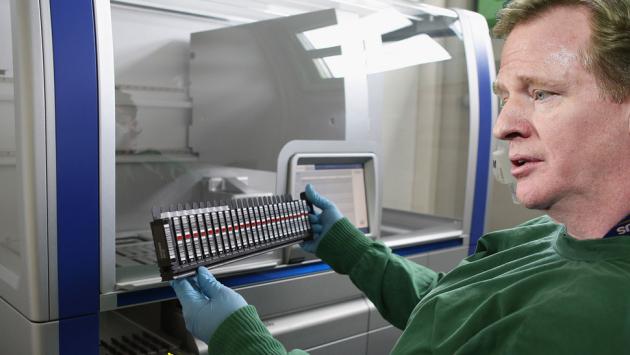How Genetic Testing in Sports Can Reveal a Whole Lot Of Data You Might Not Be Ready For
2013.10.17

Fast Company's profile on 23andMe, is worth a read. The company is the public face of genetic testing, and now they're looking at how genetic testing in sports might look like.
Writer Elizabeth Murphy had herself and her adopted daughter tested by 23andMe. Here's what she wrote:
And there it is, screaming out at me from my computer screen. My daughter, who is learning to read and tie her shoes, has two copies of the APOE-4 variant, the strongest genetic risk factor for Alzheimer's. According to her 23andMe results, she has a 55% chance of contracting the disease between the ages of 65 and 79. My husband, who is out of town on business, texts that he will call me at 8:30. "Everything okay?" he adds. "All good," I write back, "except our daughter is going to get Alzheimer's."
There are three main variants of the APOE gene: ... E4 is trouble; not only does it seem to dramatically increase the likelihood of a person developing Alzheimer's, but it also increases her chances of doing so at an earlier age. Roughly 22% of the population has one copy of e4; about 3% have two copies. My daughter's genes place her in that dreaded narrow sliver. "A vanishingly small number of [23andMe's] results fall into that category where you can say, 'Oh, all right, I'm going to get this disease or I'm not,' " says UNC's Evans. "The APOE-4 approaches that."
Meanwhile, my results show that I have a copy of the protective e2 gene, locked impotently within each of my cells, where it can do my daughter zero good. My family has found out, as Evans would say, something really scary.
ApoE4 is also believed to impair recovery from brain injuries, which might make you more susceptible to them in the first place. The idea of genetic testing in sports might shed light to how susceptible some athletes are to different types of injuries. There are three main variants of the APOE gene: ... E4 is trouble; not only does it seem to dramatically increase the likelihood of a person developing Alzheimer's, but it also increases her chances of doing so at an earlier age. Roughly 22% of the population has one copy of e4; about 3% have two copies. My daughter's genes place her in that dreaded narrow sliver. "A vanishingly small number of [23andMe's] results fall into that category where you can say, 'Oh, all right, I'm going to get this disease or I'm not,' " says UNC's Evans. "The APOE-4 approaches that."
Meanwhile, my results show that I have a copy of the protective e2 gene, locked impotently within each of my cells, where it can do my daughter zero good. My family has found out, as Evans would say, something really scary.
Will genetic testing take off in sports? The results, if bad, are heartbreaking enough in most cases. But not so much if they wanted to know about the conditions they have no control over.
"People like your daughter are invisible to pharma," Emily Drabant, a former Stanford neuroscientist who's now 23andMe's manager of business development and alliances, explains later. "The way these research studies are typically done is they bring in people with Alzheimer's, give them a drug, and see what happens. Do they get better?
Like a number of other brain diseases, the Alzheimer's process starts before you start having symptoms, so the changes in your brain are happening before you are actually manifesting dementia. Most of pharma's trials have failed, and the key takeaway is a) they may have been targeting the wrong molecule and b) they were intervening too late.
So now what pharma wants to do is new trials in people who are at high risk, who are like 60 and e4 carriers. But what's hard for pharma is this: How do you find people who don't yet have Alzheimer's and aren't sick? They're not going to a doctor. Well, we have 65,000 people in 23andMe who are e4 carriers, and we have 6,000 people in 23andMe who have the same genotype as your daughter's."
Read the whole article over at [Fast Company]Like a number of other brain diseases, the Alzheimer's process starts before you start having symptoms, so the changes in your brain are happening before you are actually manifesting dementia. Most of pharma's trials have failed, and the key takeaway is a) they may have been targeting the wrong molecule and b) they were intervening too late.
So now what pharma wants to do is new trials in people who are at high risk, who are like 60 and e4 carriers. But what's hard for pharma is this: How do you find people who don't yet have Alzheimer's and aren't sick? They're not going to a doctor. Well, we have 65,000 people in 23andMe who are e4 carriers, and we have 6,000 people in 23andMe who have the same genotype as your daughter's."
More Articles
Copyright © Fooyoh.com All rights reserved.